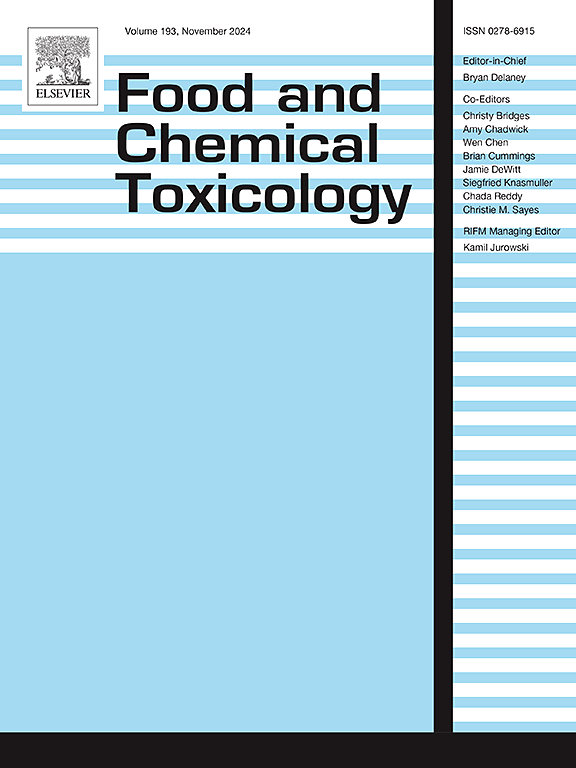TiO2 P25 nanoparticles induce mitochondrial damage and increased glutathione synthesis in SH-SY5Y neural cells
IF 3.9
3区 医学
Q2 FOOD SCIENCE & TECHNOLOGY
引用次数: 0
Abstract
The increasing occurrence of TiO2 nanoparticles in the environment leads to a higher risk of their entry into the human body. Because the nanomaterials can cross the blood-brain barrier, the knowledge of their effect in neural cells is also crucial. However, the exact mechanism of toxicity remains unclear. Therefore, our objective was to evaluate the biological effect of TiO2 nanoparticles in neural cells. Therefore, we aimed to evaluate the biological effect of TiO2 nanoparticles in neural cells. We used neuroblastoma SH-SY5Y cells treated with 25 nm TiO2 nanoparticles (TiO2 P25; 1–100 μg·mL−1; 24–72 h). We measured dehydrogenase activity, glutathione metabolism, DNA damage and mitochondrial respiration. After treatment of SH-SY5Y cells with TiO2 P25, we found a dose- and time-dependent decrease in dehydrogenase activity together with nuclear changes. Interestingly, 100 μg·mL−1 TiO2 P25 caused a significant increase of glutathione levels (p < 0.001) linked with increased glutamate-cysteine ligase expression after both 24 and 48 h. Furthermore, as the first study at all, we observed the significant decreases of mitochondrial respiration in SH-SY5Y cells caused by treatments with 10 and 100 μg·mL−1 TiO2 P25 after 48 and 72 h. In conclusion, our study brings new finding of occurrence of decreased mitochondrial respiration without glutathione depletion in SH-SY5Y cells contributing to the understanding of TiO2 P25 toxicity in neural cells.
TiO2 P25纳米颗粒诱导SH-SY5Y神经细胞线粒体损伤和谷胱甘肽合成增加
随着TiO2纳米颗粒在环境中的出现越来越多,其进入人体的风险也越来越高。由于纳米材料可以穿过血脑屏障,因此了解它们对神经细胞的影响也至关重要。然而,确切的毒性机制仍不清楚。因此,我们的目的是评估TiO2纳米颗粒在神经细胞中的生物学效应。因此,我们旨在评估TiO2纳米颗粒在神经细胞中的生物学效应。我们将神经母细胞瘤SH-SY5Y细胞用25 nm纳米TiO2 (TiO2 P25;1 - 100μg·毫升−1;24 - 72 h)。我们测量了脱氢酶活性、谷胱甘肽代谢、DNA损伤和线粒体呼吸。用TiO2 P25处理SH-SY5Y细胞后,我们发现脱氢酶活性呈剂量依赖性和时间依赖性降低,同时细胞核发生变化。有趣的是,100 μg·mL−1 TiO2 P25导致谷胱甘肽水平显著升高(p <;0.001)与谷氨酸-半胱氨酸连接酶在24和48 h后表达增加相关。此外,作为首次研究,我们观察到10和100 μg·mL−1 TiO2 P25处理48和72 h后SH-SY5Y细胞线粒体呼吸显著降低。我们的研究在SH-SY5Y细胞中发现了线粒体呼吸减少而没有谷胱甘肽耗竭的新发现,有助于理解TiO2 P25对神经细胞的毒性。
本文章由计算机程序翻译,如有差异,请以英文原文为准。
求助全文
约1分钟内获得全文
求助全文
来源期刊

Food and Chemical Toxicology
工程技术-毒理学
CiteScore
10.90
自引率
4.70%
发文量
651
审稿时长
31 days
期刊介绍:
Food and Chemical Toxicology (FCT), an internationally renowned journal, that publishes original research articles and reviews on toxic effects, in animals and humans, of natural or synthetic chemicals occurring in the human environment with particular emphasis on food, drugs, and chemicals, including agricultural and industrial safety, and consumer product safety. Areas such as safety evaluation of novel foods and ingredients, biotechnologically-derived products, and nanomaterials are included in the scope of the journal. FCT also encourages submission of papers on inter-relationships between nutrition and toxicology and on in vitro techniques, particularly those fostering the 3 Rs.
The principal aim of the journal is to publish high impact, scholarly work and to serve as a multidisciplinary forum for research in toxicology. Papers submitted will be judged on the basis of scientific originality and contribution to the field, quality and subject matter. Studies should address at least one of the following:
-Adverse physiological/biochemical, or pathological changes induced by specific defined substances
-New techniques for assessing potential toxicity, including molecular biology
-Mechanisms underlying toxic phenomena
-Toxicological examinations of specific chemicals or consumer products, both those showing adverse effects and those demonstrating safety, that meet current standards of scientific acceptability.
Authors must clearly and briefly identify what novel toxic effect (s) or toxic mechanism (s) of the chemical are being reported and what their significance is in the abstract. Furthermore, sufficient doses should be included in order to provide information on NOAEL/LOAEL values.
 求助内容:
求助内容: 应助结果提醒方式:
应助结果提醒方式:


